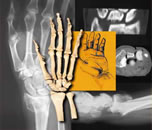


 |
|
||
Bibliography of the Distal Radius This section of eRadius is a searchable database that is continually being updated and expanded. Use the search utility in the upper right hand corner to look for specific topics or papers, or scroll through to see what might interest you. Margaliot, Haas, et al A Meta-Analysis of Outcomes of External Fixation versus Plate Osteosynthesis for Unstable Distal Radius Fractures Journal of Hand Surgery, Hand Surg [Am]. 2005 Nov;30(6):1185-99 A retrospective review was performed via MEDLINE and EMBASE for articles published between 1980 and 2004, yielding 46 articles covering 28 studies (916 patients) of external fixation and 18 studies (603 patients) with internal fixation. (Note: all the internal fixation studies were prior to 2004, so there were very few with volar plates, much less modern fixed-angle volar plates.) "Meta-analysis did not detect clinically or statistically significant differences in pooled grip strength, wrist range of motion, radiographic alignment, pain, and physician-rated outcomes between the 2 treatment arms. There were higher rates of infection, hardware failure, and neuritis with external fixation and higher rates of tendon complications and early hardware removal with internal fixation. Considerable heterogeneity was present in all studies and adversely affected the precision of the meta-analysis." The authors concluded that "The current literature offers no evidence to support the use of internal fixation over external fixation for unstable distal radius fractures. Comparative trials using appropriately sensitive and validated outcome measurements are needed to guide treatment decisions." Comment It is important that we recognize the limits of literature support for many of the choices that we make, and a negative study like this one is quite valuable. To know that we don't know is powerful knowledge. We need to perform Level I studies, if at all possible, if we are to make progress in the science and art of distal radius fracture management. Knirk, JL and Jupiter, J Intra-articular fractures of the distal end of the radius in young adults. Comment This paper is probably the most widely cited modern paper on distal radius fractures. What is disconcerting about this is the fact that Dr. Jupiter has repeatedly stated that the paper overstates the case between arthritis and intraarticular stepoff. Specifically, he has stated that the close correlation between stepoff as seen on plain radiographs and the development of arthritis as stated in the paper is incorrect. The paper has a number of limitations, including: (1) The four-step classification of stepoff (Grade 1: 0-1 mm, Grade 2: 1-2 mm, ...) contains an error. Where do you place a 1 mm stepoff? Grade 1 or 2? (2) Plain radiographs have been shown to poorly differentiate stepoffs on the order of 1 mm (3) It was a retrospective, radiographic study. They did not have any information on the ligamentous injuries of these patients, which injuries may be more important than simple stepoff measurements. Dr. Jupiter has stated that if there was only one paper he could un-write, it would be this one. I think, however, that it is important to recognize the importance of the paper, notwithstanding its limitations. If you examine the history of distal radius fractures, Dr. Jupiter showed both intellectual courage and scientific insight when he broke with the consensus of history and first brought to our attention the need to accurately reduce these fractures. While there may not be a close association between any particular amount of stepoff and the development of post-traumatic arthritis, it is the general consensus of all researchers in this area that accurate articular restoration is an important factor, if not "the most critical factor", in achieving a successful result. (reviewed by David Nelson, MD) Volar fixation for dorsally displaced fractures of the distal radius: a preliminary report. Orbay JL, Fernandez DL. Using a volar approach to avoid the soft tissue problems associated with dorsal plating, we treated a consecutive series of 29 patients with 31 dorsally displaced, unstable distal radial fractures with a new fixed-angle internal fixation device. At a minimal follow-up time of 12 months the fractures had healed with highly satisfactory radiographic and functional results. The final volar tilt averaged 5 |
|||
| About Us | Research | Basic Knowledge | What's New | Forum | Guest Professor | Post a Case | eRadius Conference | Patients | Home |